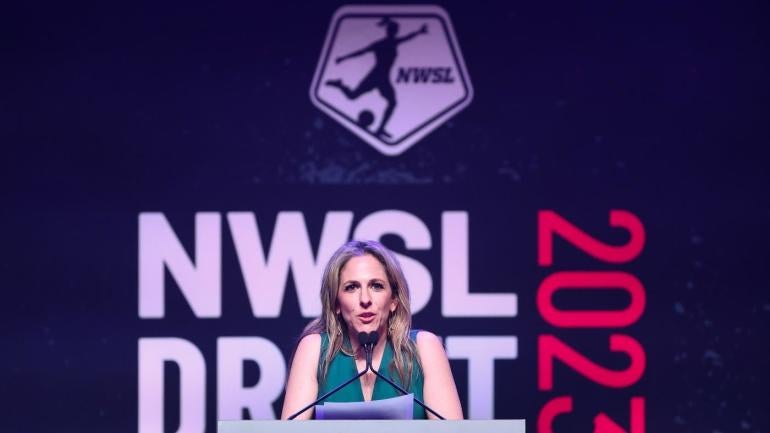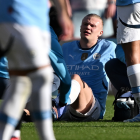
The NWSL and NWSL Players Association have announced a new collective bargaining agreement that sees the college draft and other drafts abolished. This decision makes the NWSL the first major American professional sports league to eliminate their draft. The deal was negotiated two years ahead of the original CBA expiring in 2026 and sees numerous changes for players in a league growing by the day.
The new CBA includes PA victories that eliminate all draft events, and it introduces free agency for all. League wins include staffing investment, selective charter flight use, and room for the league to create a year-round schedule. Increased salary caps and salaries are also key features in another historic contract.
The NWSL regular season will return to play on Friday, after an Olympic break, and fans can watch select NWSL matches across CBS platforms including CBS, CBS Sports Network, Paramount+, and CBS Sports Golazo Network.
The first CBA between the PA and NWSL was ratified in 2022. It set in place a number of minimum standards among them salaries and free housing, parental leave, mental health leave, and protocols to roll out free agency. Now this 2.0 version of the CBA includes all those previous wins, and more, for NWSL players.
The NWSLPA can now cross off another historic first -- the abolition of the NWSL Draft, and all other draft events including expansion drafts, and no more NWSL Discovery Rule. Additionally, all future trades, intra-league or intra-league transfers, will require player consent.
"Given our vision to be the best league in the world, we determined that this was the right time to align with global standards and achieve long-term labor peace. This CBA gives us agency over our business and gives the players agency over their careers," said NWSL commissioner Jessica Berman. "Our new agreement revolutionizes the game, raises standards, and innovates the business. On behalf of our board of governors, I want to thank our players, and their representative leadership at the NWSLPA, for working together to make this possible."
Here are some key points of the new CBA:
CBA highlights
Free agency and guaranteed contracts: Increased efforts to level the league with FIFA regulations, unrestricted free agency and guaranteed contracts will now be open to all players. The previous CBA announced free agency with a tiered roll-out over four years. Now the amount of time played in the league will no longer matter and an expiring contract for the upcoming season means the player will be eligible to negotiate new contracts with clubs.
This helps align the league with other global soccer markets where free agency and player transfers are common. Guaranteed contracts will help provide a sense of security for players who may deal with injury incidents during their time while on a club contract.
Elimination of all drafts and changes to trade protocol: All trades and transfers will require player consent from players. Draft and all other draft events will be eliminated effective immediately. This also sets NWSL on even footing with other leagues as draft events are a uniquely "American" concept.
"The draft is an antiquated model that empowers teams to decide for players instead of players deciding for themselves," said NWSLPA president Tori Huster in a release. "Now, players can choose the team environment that fits their needs and maximizes their opportunities. Teams will need to step up to create environments that appeal to players."
Entry pathways into the league were primarily through the NWSL Draft, and later, the under-18 mechanism. The U-18 mechanism is still in place, and pathways to the league will now have one less boundary for players. Expansion drafts are also voided, a previous means of building a roster for new teams will mean different methods of roster building.
Often a sore spot for players in the league, expansion drafts often came with anxious uncertainty around whether or not a player's life would be uprooted. Unlike men's pro sports leagues, wage gaps in women's leagues are vast, and while it's a major inconvenience to ask anyone to uproot their lives at a moment's notice, there's no added safety net of multi-million contracts in place to maybe help ease the process.
Improved travel policies and workload management: The new deal addresses travel conditions and game frequency. Travel accommodation protocols have been adjusted for the selective use of charter flights. Charter flights are now allowed for up to six legs (three round trips) of travel within the league season and extra charter travel is required for certain midweek matches.
Workload management will improve by addressing game frequency, including midseason breaks, and a minimum of 28 days off during the offseason. Annual games played are modified from 38 to 42 (with conditions) and game frequency limits are in place.
Revenue sharing: In another historic first, the newly bargained salary cap is tied to revenue sharing in addition to a minimum base salary cap. Clubs will be held to a "minimum spend" to ensure that sharable revenue is spent on compensation. The NWSLPA also secured auditing rights to determine compliance with the provision.
Salary and salary cap increases: The new agreement will raise the current minimum salary and there will be no limit for an individual player's maximum annual salary. The league minimum salary is set to double throughout the CBA, rising from $48,500 in 2025 to $82,500 in 2030.
Base salary caps will increase year over year as the cap has been negotiated with two components -- a base cap at predetermined levels and an additive based on the prior year's sponsorship and media revenue. Salary caps for the league will grow over the term of the agreement, from $3.3 million (2025) to $5.1 million (2030) with the door open to further increases for future revenue-sharing models.
The league will maintain the ability to raise the base salary cap at their discretion. Prior year NWSL media and sponsorship shareable revenues will add at least $200,000 to the base salary cap each year.
The base salary caps each year will be:
- 2025: $3.3 million
- 2026: $3.5 million
- 2027: $4.4 million
- 2028: $4.7 million
- 2029: $4.9 million
- 2030: $5.1 million
Want more coverage of women's soccer? Listen below and make sure to watch Attacking Third on Golazo Network Monday and Friday for all your USWNT, NWSL and WSL women's soccer coverage.
How the new CBA came to life
Early negotiations for the next CBA began in fall of 2023. In an effort to avoid labor disputes in a future media rights negotiation window, the league reached out with an offer to renegotiate early. The NWSLPA first had to weigh whether or not to accept the invitation in good faith or stick with their current CBA that originally ran through 2026.
"We had just signed our CBA in 2022, last year was 2023, so we're still living out the first CBA, working out the kinks, and learning from things that we could improve on going into the next negotiations," NWSLPA vice president Simone Charley told CBS Sports.
"I think for us, that was also another reservation of, 'Okay, like, are we well equipped? Do we know fully what we want to improve on?' But I think for us, it was pretty apparent that the pros outweighed the cons. At the end of the day, we didn't have anything to lose, because if we didn't come to terms of an agreement, then we would just continue on with our 2026 CBA. So for us, it was pretty obvious to us that it was worth the risk."
The first-ever CBA hit several historic landmarks for the players. It was the first ever CBA for a division I women's pro soccer league in the United States. It delivered minimum standards, expanded benefits to include parental or mental health leave, and offered a sense of relief that a labor contract existed between employer and employee. Though even just two seasons into their CBA, there were already different things to bring up during future negotiations.
"I feel like the first CBA did a good job of just setting the minimum standards. I think that that was something that's been lacking. As a player, you'll have completely different experiences at different clubs and it shouldn't be that way. We should have a minimum of player treatment, player standards, player welfare. I think that's what's exciting about this next CBA, is that we just elevated that," Charley said.
"This is what we deserve. I think for me, a big one, of course, is free agency for all, because as a player, you get to have control over your career, and you get to be in a place where you get to determine what's the best fit for you ... Personally, someone who's experienced season-ending injuries, I think workload management was something that was really important to me."
Workload management and free agency for all are just a few of the "wins" that Charley, a forward with Orlando Pride, is most proud of achieving in this next CBA for players. Different areas of being a women's professional athlete often intersect, and CBA victories for travel conditions tie into recovery for Charley who is currently navigating a season-ending Achilles tendon injury.
"Unfortunately, you've seen a lot in the women's game of a lot of big-time injuries happening to players, and it's so important that we are making sure that we're taking care of players, not only in day-to-day treatment but also in how often we're playing games. If we are having midweek games, can you charter a flight instead of, you know, having to walk around in the airport? It'd be an all-day affair and so that affects your recovery. That affects your body's ability to play at the highest level."
What's next?
While eliminating the draft and providing free agency for all are more historic wins for the NWSLPA and the league, it's also uncharted territory for the players union. These are processes that now exist for players and future players, but how will they navigate free agency and entryways into the league for 2025 and beyond?
"That's something we as a players association have been thinking a lot about, because now that players have a lot more power, how can we educate players to make sure that they're making quality choices and understanding everything that a club brings to the table?" said Charley.
Charley says the association is working on extended resources for current and future players to access and make the best decisions for themselves. The biggest and most telling are report cards for NWSL clubs. To date, most players already seek out knowledge by sharing information and experiences, and now they're cataloging the data for players to access for any decision-making for a future club.
"We started implementing things like a club report card so players will fill out, 'What's the training facility like?' and 'What's your experience with the staff?' and having each player fill that out. Kind of giving each club a report card and disseminating all that information out to all players, so that when you are a free agent, you can really know 'what exactly am I getting myself into?'"
![[object Object] Logo](https://sportshub.cbsistatic.com/i/2020/04/22/e9ceb731-8b3f-4c60-98fe-090ab66a2997/screen-shot-2020-04-22-at-11-04-56-am.png)

















